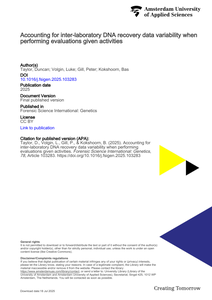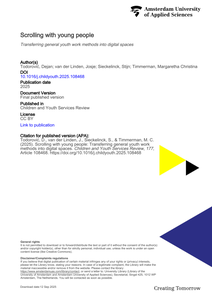BackgroundGait analysis has been used for decades to quantify knee function in patients with knee osteoarthritis; however, it is unknown whether and to what extent inter-laboratory differences affect the comparison of gait data between studies. Therefore, the aim of this study was to perform an inter-laboratory comparison of knee biomechanics and muscle activation patterns during gait of patients with knee osteoarthritis.MethodsKnee biomechanics and muscle activation patterns from patients with knee osteoarthritis were analyzed, previously collected at Dalhousie University (DAL: n = 55) and Amsterdam UMC, VU medical center (VUmc: n = 39), using their in-house protocols. Additionally, one healthy male was measured at both locations. Both direct comparisons and after harmonization of components of the protocols were made. Inter-laboratory comparisons were quantified using statistical parametric mapping analysis and discrete gait parameters.ResultsThe inter-laboratory comparison showed offsets in the sagittal plane angles, moments and frontal plane angles, and phase shifts in the muscle activation patterns. Filter characteristics, initial contact identification and thigh anatomical frame definitions were harmonized between the laboratories. After this first step in protocol harmonization, the offsets in knee angles and sagittal plane moments remained, but the inter-laboratory comparison of the muscle activation patterns improved.ConclusionsInter-laboratory differences obstruct valid comparisons of gait datasets from patients with knee osteoarthritis between gait laboratories. A first step in harmonization of gait analysis protocols improved the inter-laboratory comparison. Further protocol harmonization is recommended to enable valid comparisons between labs, data-sharing and multicenter trials to investigate knee function in patients with knee osteoarthritis.
MULTIFILE

A large, recently published, inter-laboratory study by the ReAct group has shown that there is considerable variability in DNA recovery that exists between forensic laboratories. The presence of this inter-laboratory variability presents issues when one laboratory wishes to carry out an evaluation and needs to use the data produced by another laboratory. One option proposed by the ReAct group is for laboratories to carry out a calibration exercise so that appropriate adjustments between laboratories can be made. This will address some issues, but leave others unanswered, such as how to make use of the decades of transfer and persistence data that has already been published. In this work we present a method to utilise data produced in other laboratories (whether it provides DNA amounts or a probability of transfer) that takes into account inter-laboratory variability within an evaluation. This will allow evaluations to continue, without calibration data, and ensures that the strength of findings is appropriately represented. In this paper we discuss complicating factors with the various ways in which previous data has been reported, and their limitations in supporting probability assignments when carrying out an evaluation. We show that a combination of producing calibration information for new data (as suggested by the ReAct group) and development of strategies where calibration data is not available will provide the best way forward in the field of evaluations given activities.
DOCUMENT

With the increasing significance of the online lifeworld in the lives of adolescents, youth work must adapt its methods to support young people’s personal development and social participation in this hybrid online space. To date, there is limited knowledge on how youth workers can effectively employ methodical actions in the online environment. This paper draws on established offline youth work methods to explore their potential transferability to the online context. The research question guiding this study is: How can offline youth work methods be used in the online lifeworld to support adolescents’ developmental needs? Using the Change Laboratory method, 26 youth workers from 14 youth work organisations in the Netherlands participated in this research. The findings suggest that while offline methods provide a valuable resource, they cannot be directly transferred to the online context without adaptation. Instead, they offer a framework for seven specific methodical actions that can be adapted or developed for the online context. They are: 1) Increasing online visibility and accessibility, 2) Orienting, 3) Signalling, 4) Making contact, 5) Building meaningful relationships, 6) Assessing needs, and 7) Providing support. By identifying these seven methodical actions which are crucial for addressing the developmental needs of adolescents online, this paper contributes to the growing body of knowledge on youth work in the online lifeworld.
DOCUMENT

Droop control is used for power management in DC grids. Based on the level of the DC grid voltage, the amount of power regulated to or from the appliance is regulated such, that power management is possible. The Universal 4 Leg is a laboratory setup for studying the functionality of a grid manager for power management. It has four independent outputs that can be regulated with pulse width modulation to control the power flow between the DC grid and for example, a rechargeable battery, solar panel or any passive load like lighting or heating.
DOCUMENT

Detecting practical problems of persons with dementia (PwD) experience at home, and advising them on solutions to facilitate aging in place are complex and challenging tasks for nurses and case managers. In this two group randomized, controlled laboratory experiment, the efficacy of a decision support application aiming to increase nurses' and case managers' confidence in clinical judgment and decision-making was tested. The participants (N = 67) assessed a case of a PwD within the problem domains: self-reliance, safety and informal care, and provided suggestions for possible solutions. Participants used either their regular procedure with (intervention group) or without the App (control group) to conduct these tasks. No statistically significant difference was found on the primary outcome measure, the overall level of confidence. However, nurses and case managers highly recommended use of the App in practice. To explain these results, more research on the potential added value of the App is needed.
DOCUMENT

Technological innovations enable rapid DNA analysis implementation possibilities. Concordantly, rapid DNA devices are being used in practice. However, the effects of implementing rapid DNA technologies in the crime scene investigation procedure have only been evaluated to a limited extent. In this study a field experiment was set up comparing 47 real crime scene cases following a rapid DNA analysis procedure outside of the laboratory (decentral), with 50 cases following the regular DNA analysis procedure at the forensic laboratory. The impact on duration of the investigative process, and on the quality of the analyzed trace results (97 blood and 38 saliva traces) was measured. The results of the study show that the duration of the investigation process has been significantly reduced in cases where the decentral rapid DNA procedure was deployed, compared to cases where the regular procedure was used. Most of the delay in the regular process lies in the procedural steps during the police investigation, not in the DNA analysis, which highlights the importance of an effective work process and having sufficient capacity available. This study also shows that rapid DNA techniques are less sensitive than regular DNA analysis equipment. The device used in this study was only to a limited extent suitable for the analysis of saliva traces secured at the crime scene and can mainly be used for the analysis of visible blood traces with an expected high DNA quantity of a single donor.
DOCUMENT

Inertial measurement units (IMUs) allow for measurements of kinematic movements outside the laboratory, persevering the athlete-environment relationship. To use IMUs in a sport-specific setting, it is necessary to validate sport-specific movements. The aim of this study was to assess the concurrent validity of the Xsens IMU system by comparing it to the Vicon optoelectronic motion system for lower-limb joint angle measurements during jump-landing and change-of-direction tasks. Ten recreational athletes performed four tasks; single-leg hop and landing, running double-leg vertical jump landing, single-leg deceleration and push off, and sidestep cut, while kinematics were recorded by 17 IMUs (Xsens Technologies B.V.) and eight motion capture cameras (Vicon Motion Systems, Ltd). Validity of lower-body joint kinematics was assessed using measures of agreement (cross-correlation: XCORR) and error (root mean square deviation and amplitude difference). Excellent agreement was found in the sagittal plane for all joints and tasks (XCORR > 0.92). Highly variable agreement was found for knee and ankle in transverse and frontal plane. Relatively high error rates were found in all joints. In conclusion, this study shows that the Xsens IMU system provides highly comparable waveforms of sagittal lower-body joint kinematics in sport-specific movements. Caution is advised interpreting frontal and transverse plane kinematics as between-system agreement highly varied.
DOCUMENT

In this paper, we share insights from our creative practice-based experimentation with ‘feral’ ways of stimulating eco-social change. Drawing on our experiences with three practice-based research projects – Open Forest, Cyano Automaton, and Open Urban Forest – we discuss how feral ways may foster more-than-human co-creation of knowledge and data, and nurture pluralistic making sense-with other-thanhuman creatures. We first explore the concept of feral in supporting the understanding of how creative eco-social inquiries may evolve beyond the bounds of anthropocentrism, in relation with more-than-human experiences. Through our three cases, we illustrate how experimenting with feralness can bring to the fore issues of power, agency, and control in the currently human-centric discourses around data, technology, and sensemaking in eco-social transformation. By sharing our emerging insights regarding feral ways, our aim is to help nurture critical, more-than-human perspectives in creative practice-based inquiries in art and design.
MULTIFILE

Habitual behavior is often hard to change because of a lack of self-monitoring skills. Digital technologies offer an unprecedented chance to facilitate self-monitoring by delivering feedback on undesired habitual behavior. This review analyzed the results of 72 studies in which feedback from digital technology attempted to disrupt and change undesired habits. A vast majority of these studies found that feedback through digital technology is an effective way to disrupt habits, regardless of target behavior or feedback technology used.
DOCUMENT

This article presents and discusses an extracurricular, co-constructed programme: “The Catalyst Club” as a form of Artistic Educational Commoning (AEC). Having been developed as part of a PhD research at Minerva Art Academy (Groningen, TheNetherlands), The Catalyst Club (TCC) explored new perspectives on the education of artists and designers in a globalized world and created alternative modes of operating in higher art education. It brought together students, alumni, teachers from a range of disciplines, and external participants. During developing TCC, the author occupied a dual role as researcher and participant, working together with others in an artistic co-creative process. TCC drew on and developed the methods relating to Collaborative Autoethnography, Participatory Action Research and Artistic Research. This study presents AEC as a communal effort to build spaces for learning and experimentation. They are created through interaction and cooperation, based on social relations and the production of shared values. As such it can offer a counterbalance to the extensive individualisation, instrumentalization, and commodification of communities in higher art education. The article formulates some recommendations on how AEC can reconnect the education of artists and designers with the role of the arts in wider technological, societal, and political contexts.
DOCUMENT
